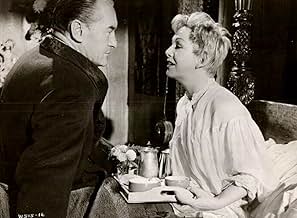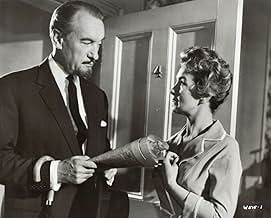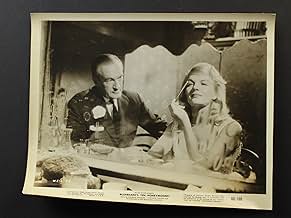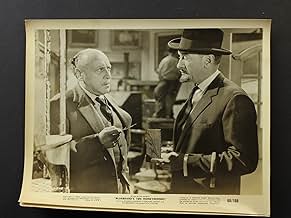Zehn Frauen verschwanden in Paris
Originaltitel: Bluebeard's Ten Honeymoons
IMDb-BEWERTUNG
6,1/10
262
IHRE BEWERTUNG
Füge eine Handlung in deiner Sprache hinzuA golddigger inspires her older lover to murder wealthy women for the finances to keep her happy.A golddigger inspires her older lover to murder wealthy women for the finances to keep her happy.A golddigger inspires her older lover to murder wealthy women for the finances to keep her happy.
Harold Berens
- Jeweller
- (Nicht genannt)
Ernest Blyth
- Parisian Bystander
- (Nicht genannt)
Dino Galvani
- Hardware Store Owner
- (Nicht genannt)
Empfohlene Bewertungen
This tale of a man stalking women intent on murder reminded me of Psycho (1960). None of the murders here are as shockingly graphic as the famous shower scene in Psycho, but one comes close. "Bluebeard's Ten Honeymoons" will never achieve the fame of Alfred Hitchcock's Psycho, but it makes Psycho look like a one trick pony, that trick being the famous shower scene (in fact, Hitchcock said that he made Psycho just for the shower scene), and it exceeds Psycho on plot, intrigue and suspense.
Henri Landru ( George Sanders ) is totally enchanted by a glamourous night club singer, Odette ( Corinne Calvet ). For some reason he fails to see something that is quite obvious, all she wants him for is his money. He makes only a modest living from dealing in fine art and antiques and so, to get his hands on enough money to keep the glamourous golddigger happy, he resorts to crime.
He answers a newspapaper small-ad from a woman wishing to sell her furniture. He hopes to make money from the deal. The lady Vivienne Dureaux ( Patricia Roc ) falls for Landru and trusts him completely. Before he can find the right buyer, she finds one herself and so he is cut out of the deal. Desperate for money to keep Odette happy, he tries to persuade Vivienne to let him invest the proceeds of the sale. She isn't keen on the idea, and driven by his obsession for Odette, the usually charming Landru becomes rather menacing. Vivienne become scared and backs away. She has a fall and is left unconscious. Landru kills her making the death appear to be suicide. The other buyer has not yet collected the furniture, so Landru steals it along with anything else of value in her flat.
The experience was an education for Landru and he embarks on a career of preying on vulnerable wealthy women. A previously honest man has made the conversion to a criminal and not merely a simple thief, he is a serial killer.
For a dark subject, there were brief moments when this film seemed like a comedy, albeit a macabre comedy, with Landru's comments making it seem more like a spoof of a murder film, but they are brief and don't spoil the film. Perhaps the brief moments of light relief even improve it.
It also had moments when it was unrealistic and annoyingly stupid with some scenes almost warranting a mention on the Goofs page, but to be fair, as the plot moves on, these shortcomings can be overlooked and I'm sure many people will watch it and enjoy it untroubled by such matters.
One example of unrealism is that Landru's first victim,Vivienne, had a sister, Giselle ( Ingrid Hafner ), who went to the police to report that her sister was missing. The police had an unidentified woman's body on their files, a case of suspected suicide, and so they would, presumably, have been on the lookout for reports of missing women, but the police inspector refuses to take any action and he dismisses the disappearance as not suspicious. Based on the flimsiest of evidence he claims that Vivienne has probably gone away with a man, when that unidentifed suicide victim was in fact, Giselle's sister.
Another example of lack of realism is a policeman who accepts Landru's explanation for being on a building site in the dead of night and shovelling soil into a trench. The policeman asks him what he is doing. Landru quickly conjures up an "explanation" and the policeman accepts it and goes on his way, he doesn't ask for identification or even ask his name. Landru was actually dumping two suitcases full of body parts into the trench.
Look out for more unrealistic details near the end.
Criticism over. Those weak spots are heavily outweighed by the good points of this film. It is intruging and each time Landru is about to knock off his next victim, he exudes menace in a way that easily ranks alongside the bulld up to Hitchcock's famous shower scene.
Without trying to imitate Hitchcock stylishly, this well-crafted film has a plot worthy of Hitchcock and enough intrigue, suspense and tension to match any of his films, and so I give it nine out of ten.
A point of interest. Landru plays a dealer in fine arts and antiques. In real life, Corinne Calvet (Odette) first studied criminal law at the Sorbonne, but then turned her attention to interior decoration specializing in fine arts and antiques.
Henri Landru ( George Sanders ) is totally enchanted by a glamourous night club singer, Odette ( Corinne Calvet ). For some reason he fails to see something that is quite obvious, all she wants him for is his money. He makes only a modest living from dealing in fine art and antiques and so, to get his hands on enough money to keep the glamourous golddigger happy, he resorts to crime.
He answers a newspapaper small-ad from a woman wishing to sell her furniture. He hopes to make money from the deal. The lady Vivienne Dureaux ( Patricia Roc ) falls for Landru and trusts him completely. Before he can find the right buyer, she finds one herself and so he is cut out of the deal. Desperate for money to keep Odette happy, he tries to persuade Vivienne to let him invest the proceeds of the sale. She isn't keen on the idea, and driven by his obsession for Odette, the usually charming Landru becomes rather menacing. Vivienne become scared and backs away. She has a fall and is left unconscious. Landru kills her making the death appear to be suicide. The other buyer has not yet collected the furniture, so Landru steals it along with anything else of value in her flat.
The experience was an education for Landru and he embarks on a career of preying on vulnerable wealthy women. A previously honest man has made the conversion to a criminal and not merely a simple thief, he is a serial killer.
For a dark subject, there were brief moments when this film seemed like a comedy, albeit a macabre comedy, with Landru's comments making it seem more like a spoof of a murder film, but they are brief and don't spoil the film. Perhaps the brief moments of light relief even improve it.
It also had moments when it was unrealistic and annoyingly stupid with some scenes almost warranting a mention on the Goofs page, but to be fair, as the plot moves on, these shortcomings can be overlooked and I'm sure many people will watch it and enjoy it untroubled by such matters.
One example of unrealism is that Landru's first victim,Vivienne, had a sister, Giselle ( Ingrid Hafner ), who went to the police to report that her sister was missing. The police had an unidentified woman's body on their files, a case of suspected suicide, and so they would, presumably, have been on the lookout for reports of missing women, but the police inspector refuses to take any action and he dismisses the disappearance as not suspicious. Based on the flimsiest of evidence he claims that Vivienne has probably gone away with a man, when that unidentifed suicide victim was in fact, Giselle's sister.
Another example of lack of realism is a policeman who accepts Landru's explanation for being on a building site in the dead of night and shovelling soil into a trench. The policeman asks him what he is doing. Landru quickly conjures up an "explanation" and the policeman accepts it and goes on his way, he doesn't ask for identification or even ask his name. Landru was actually dumping two suitcases full of body parts into the trench.
Look out for more unrealistic details near the end.
Criticism over. Those weak spots are heavily outweighed by the good points of this film. It is intruging and each time Landru is about to knock off his next victim, he exudes menace in a way that easily ranks alongside the bulld up to Hitchcock's famous shower scene.
Without trying to imitate Hitchcock stylishly, this well-crafted film has a plot worthy of Hitchcock and enough intrigue, suspense and tension to match any of his films, and so I give it nine out of ten.
A point of interest. Landru plays a dealer in fine arts and antiques. In real life, Corinne Calvet (Odette) first studied criminal law at the Sorbonne, but then turned her attention to interior decoration specializing in fine arts and antiques.
This little film is among the best of Georges Sanders performances, where he is as exquisite as usual, as he was in Albert Lewin's features. This cynical and ruthless old dandy character suits him like a glove. The typical character that built his legend, an unforgettable actor. Landru, his character, is of course inspired by the notorious french serial killer from the forties. And, most of all, this movie is the best one made by W Lee Wilder who rather directed grade Z science fiction or thriller movies. This film, shown without the director's name, I would have never bet a cent on him. I even doubt that he actually made this film. It looks like an Edgard Ulmer's film instead, and certainly not W Lee Wilder, although some of his films were not totally dull either, crime flicks I mean, not Science fiction. Yes this is the W Lee Wilder's masterpiece.
This one had me scratching my head. It's directed by Billy Wilder's brother and written by his nephew. I wondered if someone thought they were making a comedy, but Billy had gotten all the sense of humor in the family. Either that, or someone thought that Chaplin's MONSIEUR VERDOUX was too silly.
George Sanders plays his usual faux-charming role, but without any wit in the writing, he's very dull. He's in love with a young singer, but all she's interested in is money, so he decides to kill other women so he can give their jewelry to her. This goes on for a while in a manner that is neither horrific nor funny.
This movie was banned in Finland. I'm not sure why they bothered.
George Sanders plays his usual faux-charming role, but without any wit in the writing, he's very dull. He's in love with a young singer, but all she's interested in is money, so he decides to kill other women so he can give their jewelry to her. This goes on for a while in a manner that is neither horrific nor funny.
This movie was banned in Finland. I'm not sure why they bothered.
This is quite a stylish suspense, which would not have been the same if not in black and white. George Sanders portrays a middle-aged man losing his head for a mercantile young temptress (a very good performance by Corinne Calvet), and finding himself driven into a series of cold-blooded murders. Sanders makes the film what it is with his convincing portrayal of an obsessed and relentless character. If not for the dull ending, this would have been a great film noir; however, it does not live up to Sanders' charismatic and sarcastic appearance, which seems to be squeezed into a predictable thriller. Nevermind, still quite enjoyable. 6/10.
1960's "Bluebeards Ten Honeymoons" (no apostrophe) is a low budget British take on Henri Landru, a lesser effort than 1944's "Bluebeard" or 1947's "Monsieur Verdoux," but easily the best feature from the undistinguished W. Lee Wilder (brother of director Billy Wilder, long estranged), and scripted by Myles Wilder, son of 'Willie,' nephew of Billy. Distinguished by the always formidable presence of George Sanders in the tailor made title role, having fallen for a gold digging chanteuse (Corinne Calvet) who leads him to commit a series of financially rewarding murders (but not once marrying a single one). The first death (Patricia Roc) is the only accidental one, her determined sister (Ingrid Hafner) bringing about the killer's downfall, but not before he finally exacts revenge on his philandering mistress. The not unattractive Corinne Calvet had seen better days, and would soon be relegated to mostly television roles, her drunken character so unappealing that one wonders why Landru would be so besotted with her, at a loss calculated in his little black book to be 30,000 francs. George Sanders, now happily married to his beloved Benita Hume, would triumph again with his next film, the classic "Village of the Damned," while veteran George Coulouris is once again wasted in a small role. Alas, most of the victims are dispatched too quickly to make much of an impression, but among them are Greta Gynt, who co-starred with Bela Lugosi in 1939's "The Dark Eyes of London," and Maxine Audley, remembered for both 1960's "Peeping Tom" and 1969's "Frankenstein Must Be Destroyed." Ingrid Hafner would soon play Dr. David Keel's nurse through the entire first season of THE AVENGERS, but would not return after Ian Hendry bowed out of the series, leaving Patrick Macnee to carry on with other partners. W. Lee Wilder's Hollywood career featured titles like "Once a Thief," "Manfish" (both with Lon Chaney), "Phantom from Space," "Killers from Space," "The Snow Creature," and "Fright," four of which found their way on to Pittsburgh's Chiller Theater, which aired "Bluebeards Ten Honeymoons" a total of four times (curiously, still unavailable on VHS or DVD). Winding down in Europe, things hardly improved for 'Willie,' with "The Man Without a Body," "Spy in the Sky!" and this picture, bowing out in 1967 with "The Omegans," shot in the Philippines (brother Billy would refer to him as a 'dull son of a b--ch').
Wusstest du schon
- WissenswertesGeorge Sanders may not have been entirely serious when he said in his autobiography that he had confused W. Lee Wilder with his more famous brother Billy Wilder, but it is true that W. Lee Wilder only got into the movie business (in middle age) because he wanted to emulate his younger brother's success and he seems to have deliberately called himself "W. Lee" rather than Wilhelm, and encouraged people to call him "Willy", because he hoped to be linked with him. Billy Wilder took a dim view of this and took care to separate himself from his brother's movie activities, which were confined to B-movies and cheap exploitation pictures. On the rare occasions when he mentioned him to interviewers, he was extremely disparaging, and they were long estranged.
- Crazy CreditsJust before the Title appears on screen, the numbers 1 to 10 are displayed, one at a time, in numerical order.
Top-Auswahl
Melde dich zum Bewerten an und greife auf die Watchlist für personalisierte Empfehlungen zu.
Details
- Erscheinungsdatum
- Herkunftsland
- Sprache
- Auch bekannt als
- Bluebeard's Ten Honeymoons
- Drehorte
- Produktionsfirma
- Weitere beteiligte Unternehmen bei IMDbPro anzeigen
- Laufzeit1 Stunde 32 Minuten
- Farbe
- Seitenverhältnis
- 1.85 : 1
Zu dieser Seite beitragen
Bearbeitung vorschlagen oder fehlenden Inhalt hinzufügen

Oberste Lücke
By what name was Zehn Frauen verschwanden in Paris (1960) officially released in Canada in English?
Antwort





























